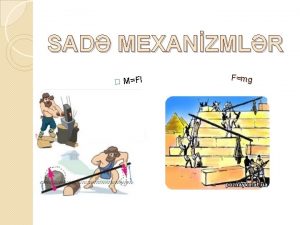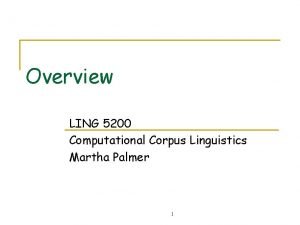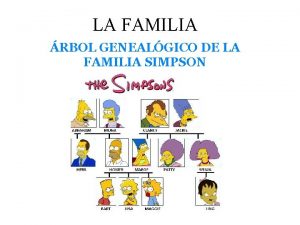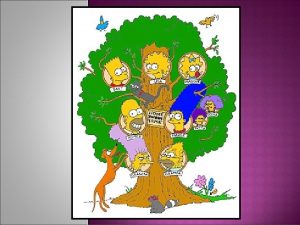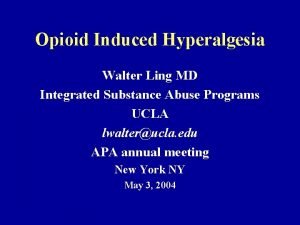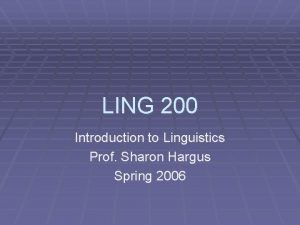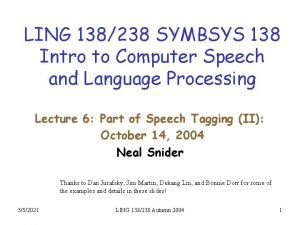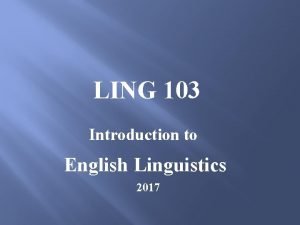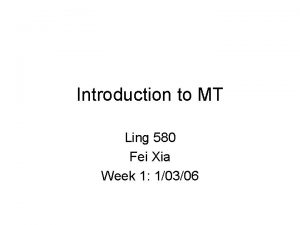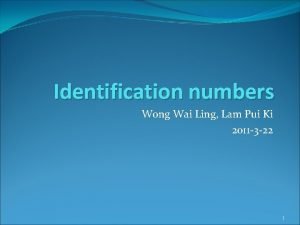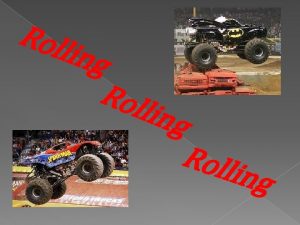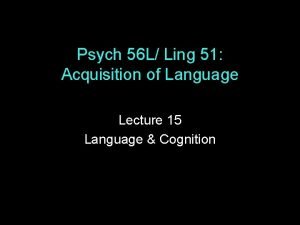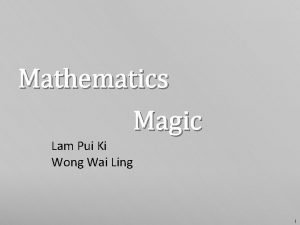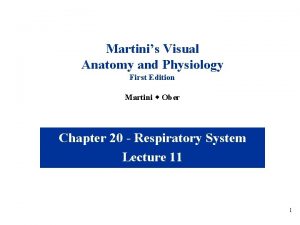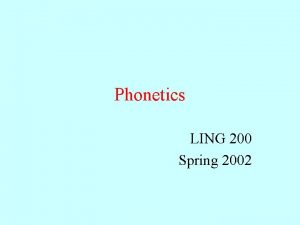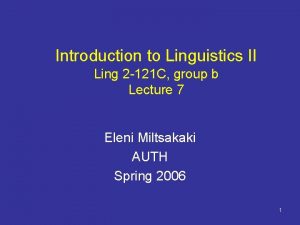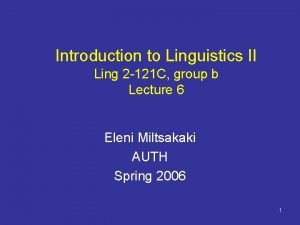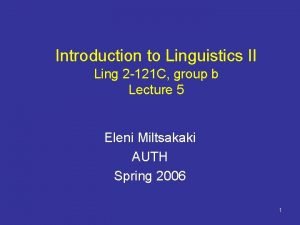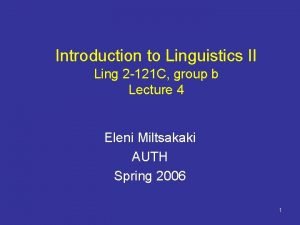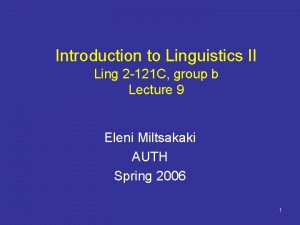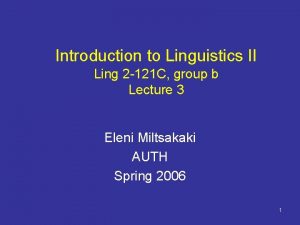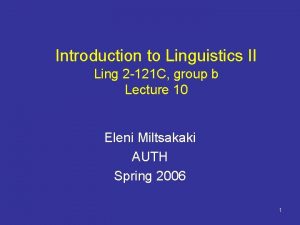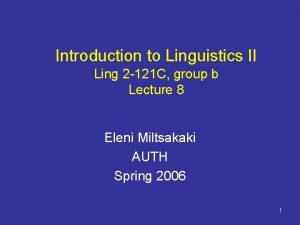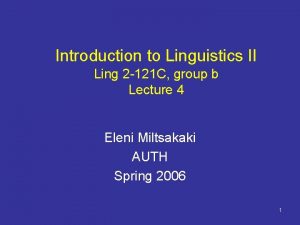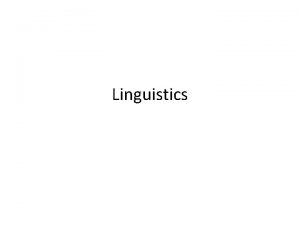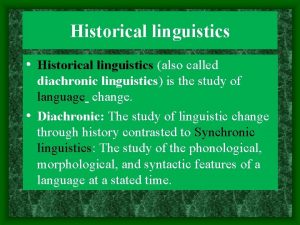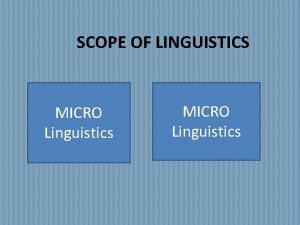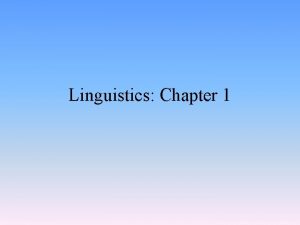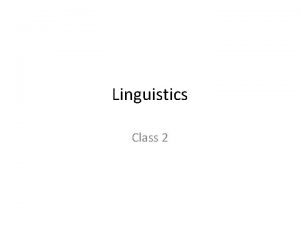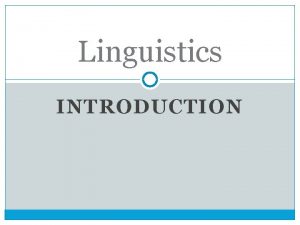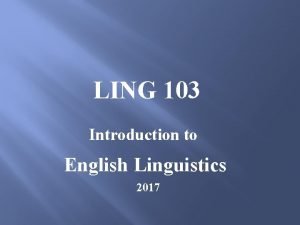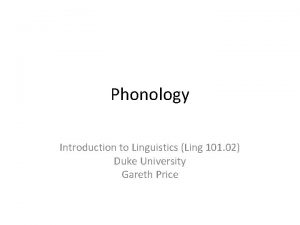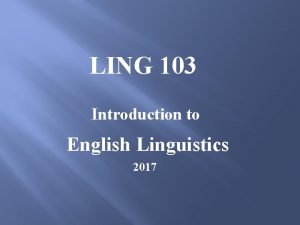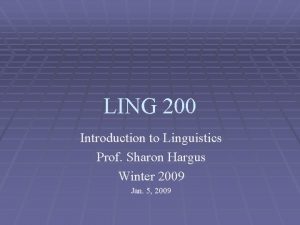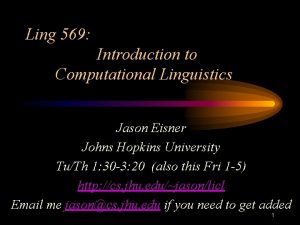Introduction to Linguistics II Ling 2 121 C

































- Slides: 33

Introduction to Linguistics II Ling 2 -121 C, group b Eleni Miltsakaki AUTH Spring 2006 1

Course outline • Morphology – Content words and function words – Bound and free morphemes – Word formation processes • • Syntax Semantics Pragmatics Historical Linguistics 2

What is morphology? • The study of the structure of words – Words are part of our linguistic knowledge – Words are part of our mental grammars 3

Basic questions for morphology • What are words and how are they formed? • How are complex words formed from simpler parts? • What are the basic building blocks in the formation of complex words? • How is the meaning of the complex word related to the meaning of its parts? • How are individual words of a language related to other words of the language? 4

What do we know when we know a ‘word’? • • • Phonological info: How it is pronounced Morphological info: Its internal structure Syntactic info: Part of speech Semantic info: What it means Pragmatic info: How we use it 5

What is a word? • Video-show • An arbitrary pairing of sound and meaning – E. g. house, casa, maison etc 6

Content and function words • Content words – They denote concepts – They are open class – They are nouns, adjectives, adverbs • Function words – They have a grammatical function – They are closed class – They are conjunctions, prepositions, articles, demonstratives, pronouns 7

Simple and complex words • Simple words – Minimal unit – Cannot be further analyzed – E. g. tree • Complex words – Made of more than one part – E. g. trees We need a name for the parts which combine to make complex words 8

Morphemes • Morphemes are the building blocks of complex words – ‘Trees’: base morpheme + plural morpheme • Types of morphemes – Free: independent words – Bound: affixes 9

Types of affixes • Prefixes: They are attached to the beginning of another morpheme – • E. g. rewrite, rethink Suffixes: They are attached to the end of another morpheme – • E. g. modernize, centralize Infixes: They are attached within another morpheme (less common but certain languages do have infixes) – E. g. kayu = wood -in- = product of a completed action kinayu = gathered wood 10

How are new words created? • • Word formation rules (derivations) Coining Compounding Blending Acronyms Clippings Backformation Conversion 11

Derivational morphology • Bound morphemes added to a root morpheme to form a new word with new meaning are called derivational morphemes. • E. g. -ify, -cation pure purify purification | | to make pure the process of making pure “pouzy” pouzify pouzification • The form that results from the addition of a derivational morpheme is called derived word 12

The hierarchical structure of words • Morphemes are added in a fixed order according to the morphological rules of a language • E. g. systematic unsystematic 13

Tree diagrams • The hierarchical organization of words can be represented in a tree diagram Adjective Un Adjective Noun system atic 14

Adverb Adjective un ly al Adjective Noun atic system *unsystem 15

More about trees • Tree diagrams are the linguist’s hypothesis of how speakers represent the internal structure of words • Take a look at ambiguous cases such as unlockable 16

Not able to be locked Able to be unlocked Adjective Verb un able Adjective un Verb verb able lock 17

• If words were only strings of morphemes without any internal organization, we could not explain the ambiguity of words like ‘unlockable’ 18

Inflectional morphology • Inflectional morphology indicates grammatical aspects of a word – Plurality (boy – boys) – Tense (walk – walked) – Person (walk – walks) • In English all inflectional morphemes are suffixes 19

How many morphemes? 1. 2. 3. 4. 5. 6. 7. 8. 9. 10. Retroactive Befriended Televise Margin Psychology Unpalatable Deactivation Airsickness Grandmother Morphemic 20

Can you “tree” the ambiguity? A: Have you finished your ten-page book report, Norman? B: I haven’t even started it. A: But it’s due tomorrow! I started mine a month ago! Why did you wait until last minute? ? B: Perhaps I have more confidence in my intellectual abilities that you have in yours! Besides, how long could it possibly take to read a ten-page book? 21

Coining • Speakers invent (coin) new words to describe previously non-existent objects • E. g. , xerox, fax, nylon, vaseline etc 22

Compounding • When two or more words are combined to form a new word • E. g. , bittersweet, homework, spoonfeed, sleepwalk etc. • In English the rightmost of a compound is the head of the compound – Noun+verb=verb, e. g. , spoonfeed 23

Meaning of compounds • The meaning of compounds is not always the sum of its parts • E. g. a blackboard maybe green or white • Also – A boathouse is a house for boats but a cathouse is not a house for cats (slang for whorehouse) – A jumping bean is a bean that jumps, a falling star is a star that falls but a looking glass is not a glass that looks – Peanut oil and olive oil but baby oil? 24

Pronunciation of compounds • In a compound the first word is usually stressed: • Compare: REDcoat (slang for British soldier) with red COAT 25

Blending • The combination of two separate forms to produce a single new term – Smoke + fog = smog – Breakfast + lunch = brunch – Motor + hotel = motel 26

Acronyms • Acronyms are words derived from the initials of several words – NASA, from National Aeronautics and Space Agency – UNESCO, from United Nations Educational, Scientific, and Cultural Organization – Radar, from radio detecting and ranging – Laser, from light amplification by stimulated emission of radiation – Scuba, from self-contained underwater breathing apparatus – RAM, random access memory 27

Backformation • A new word may enter the language because of an incorrect morphological analysis – beggar beg – editor edit – Enthusiasm enthuse 28

Abbreviation • Abbreviations of longer words may be lexicalized – Fax facsimile – Telly television – Gym gymnasium 29

Eponyms • Eponyms are words derived from proper names – Sandwich: named for the fourth Earl of Sandwich who put his food between two slices of bread so that he could eat while he gambled 30

Clipping • Clipping occurs when a word of more than one syllable is reduced to a shorter form – Fan fanatic – Plane airplane – Pro professional – Lab laboratory – Gas gasoline 31

Conversion • Conversion is a change in the function of a word – Verbs nouns (guess, must, spy, etc. ) – Adjectives verbs (dirty, empty, total, etc. ) – Particles verbs (up, down) 32

33
 Traditional linguistics and modern linguistics
Traditional linguistics and modern linguistics Difference between linguistics and applied linguistics
Difference between linguistics and applied linguistics Jin ling cigarettes
Jin ling cigarettes Tərpənməz blok
Tərpənməz blok Ling
Ling Erin ling
Erin ling Ling oa
Ling oa Mei-ling from singapore was preparing
Mei-ling from singapore was preparing Padres de marge simpson
Padres de marge simpson Dr ng li ling
Dr ng li ling Nien-ling wacker
Nien-ling wacker Supperprof
Supperprof Ling simpson
Ling simpson Ling adder
Ling adder Who's this
Who's this Walter ling
Walter ling Ling
Ling Ling
Ling Ling
Ling Mtling
Mtling Wai ling lam
Wai ling lam Ling oa
Ling oa Wang ling relationship
Wang ling relationship Shi sheng ling
Shi sheng ling Ling rolled
Ling rolled Crista terminalis
Crista terminalis False belief test
False belief test Cheung yin ling
Cheung yin ling Wai ling lam
Wai ling lam Fir tree in lung
Fir tree in lung Short-term and long-term goals examples
Short-term and long-term goals examples Mei-ling huang
Mei-ling huang Ling 200
Ling 200 Ling internet
Ling internet



